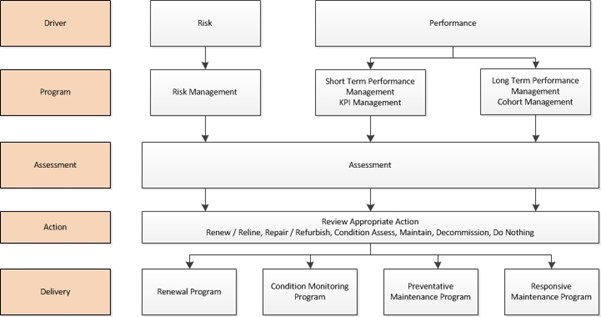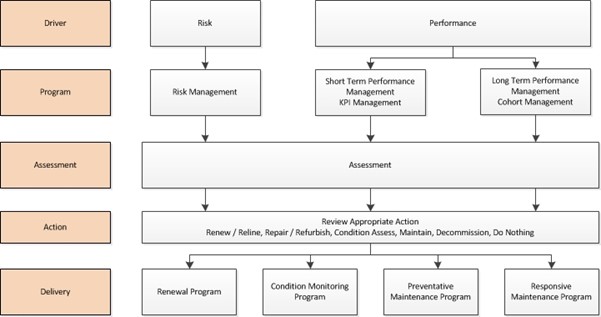Managing aging assets

Many water utilities are dealing with an aging asset base and the challenge of how to maintain risk and performance outcomes in an environment where cost is often constrained.
We hear asset managers speak about the ‘bow-wave’ of renewals required to manage particular asset classes, but how do we prudently and efficiently maintain the long term performance of our assets to avoid this ‘bow-wave’, if possible?
Here we have described a couple of approaches to think about when managing aging assets, we’d love to hear what approaches you take to manage aging assets.
An important step is to develop a planning approach which considers risk and KPI performance while also considering the management of long term asset performance. Figure 1 presents an example of an Asset Management Planning Approach.
When managing aging assets, and making decisions under Risk and Performance Management Programs, it is important to understand an asset’s likelihood of failure. There are different approaches to assess likelihood of failure, for example;
- Asset Age Based: Where the likelihood of failure is based on the age of the asset, this assessment may also consider the asset material, environment, and the achieved life of other like assets.
- Service Performance Based: Where the likelihood of failure is based on the performance history of the individual asset.
- Structural Condition Based: Where the likelihood of failure is based on the output of a physical condition assessment completed for the individual asset.
Different approaches for assessing likelihood of failure may be appropriate for different Programs and asset classes, for example;
- If an asset is assessed as high risk based on asset age, it may be appropriate to complete a structural condition assessment to confirm the risk prior to renewal (Structural Condition Based decision)
- If an asset is assessed to be performing poorly and not meeting its service KPI, it may be appropriate to review options for renewal, repair or maintenance rather than complete detailed condition assessment (Service Performance Based decision)
- If it is identified that a group of like assets are failing and an action has been identified, it may be appropriate to apply the action to other like assets even if the other assets have not yet failed (Asset Age Based decision)
If you have any questions about this publication, please contact Rebecca Kendall, Geoff Hales or Norbert Schaeper.
This article was written on behalf of the AWA’s Asset Management Specialist Network.


